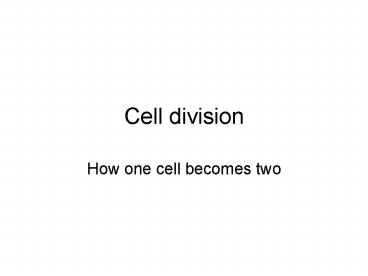Cell division PowerPoint PPT Presentation
Title: Cell division
1
Cell division
- How one cell becomes two
2
Mitosis Cytokinesis Cell division
- Most cells in all eukaryotic organisms will
divide many times throughout the life of the
organism - Mitosis is the process by which a cell duplicates
its genetic materials (chromosomes and prepares
for cell division - Cytokinesis is the division of the rest of the
cell into two different daughter cells - Prokaryotes also divide through binary fission,
but this is NOT mitosis/cytokinesis - In animals, cell division occurs during embryonic
development, growth, and wound healing - Errors during cell division can cause cell death
or cancer
3
Mitosis reorganizes DNA in the cell
- Prior to mitosis, the cell creates an exact
duplicate of its DNA material - During mitosis, the two copies are reorganized,
repackaged into two sets of chromosomes, and
divided to opposite ends of the cell - In most organisms, mitosis is immediately
followed by cytokinesis (the cell body dividing
in two) - The original cell (mother cell) is identical to
the two resulting cells (daughter cells)
4
Mitosis vocabulary
- Nucleus location of DNA inside the cell
- Nuclear envelope the membrane that separates
the nucleus from the cytoplasm - DNA an incredibly long molecule that contains
genetic blue prints for cell behavior - Chromatin a loosely bundled coil of DNA. Most
of the time, DNA is organized in this form, a
loose rope - Histones proteins which hold a DNA strand
together in the form of chromatin - Chromosome a highly organized form of
chromatin, a tightly wrapped and carefully
knotted rope - Each chromosome is composed of two identical
parts called chromatids - Chromatids two halves of a chromosome which
contain the same genetic information - DNA exists in the form of chromosomes only during
mitosis - Each chromosome looks like an X
- Centromere a bundle of proteins which connects
the two chromatids of a chromosome, the knot at
the center of the X - Microtubules part of a cells cytoskeleton.
These are tubes of protein which use to pull
chromosomes apart and to opposite ends of a cell
during mitosis. They are powered by ATP! - Mitotic spindle How microtubules are organized
during mitosis. This is a collection of
microtubule fibers which is formed to coordinate
the pulling of apart of chromosomes. - Metaphase plate the line along which
chromosomes are lined up during mitosis. This
arrangement is coordinated by the mitotic
spindle.
5
Chromosome Structure
6
5 Phases of Mitosis
- Mitosis is composed of five phases
- Prophase
- Prometaphase
- Metaphase
- Anaphase
- Telophase
- During each phase, different proteins in the cell
perform specific roles to divide the two copies
of genetic material - Cytokinesis occurs after mitosis to create two
cells
7
(No Transcript)
8
Prophase
- Chromatin is being organized into chromosomes
inside the nucleus - Microtubules are organized into mitotic spindles
in the cytoplasm - Nuclear envelope is dissolving
- By the end of prophase
- Chromosomes and mitotic spindle are fully
organized - Nuclear envelope has disappeared
9
Prometaphase
- Chromosomes move towards each other and into the
center of the cell - Microtubules move into the nuclear region and
begin to connect to chromosomes at the centromere - Microtubules organize into two mitotic spindles,
one at each end of the cell
10
Metaphase
- The mitotic spindle is fully organized, and has
pulling the chromosomes to the center of the cell - The spindle aligns chromosomes so that each
centromere is lined up along the metaphase plate
(the center of the cell)
11
Anaphase
- Each chromosome is pulled apart into two
chromatids (halves) at the centromere - Microtubule fibers contract (using ATP!), pulling
chromatids to opposite ends of the cell towards
the two spindles
12
Telophase
- Chromatids arrive at opposite ends of the cell
and begin to unfold into loose coils of
chromatin - New nuclear envelopes begin to form around the
chromatin to create two nuclei - Spindle fibers disperse into the cytoplasm
- The cell membrane begins to cleave in preparation
for cytokinesis
13
Cytokinesis
- The cell membrane is being pinched off to form
two separate compartments - Cytoplasm and organelles are being divided
between the two forming cells - At the end of cytokinesis, the membrane fuses to
create two daughter cells which contain identical
copies of DNA, and equal amounts of cytoplasm and
organelles - Cell division is complete!
14
Cell division movies
- http//www.youtube.com/watch?vVlN7K1-9QB0
- http//www.youtube.com/watch?vCzPGhYiGyZ8feature
related - Embryonic division in the worm c.elegans
http//www.youtube.com/watch?vzsgOl04PESINR1 - http//www.cellsalive.com/mitosis.htm

